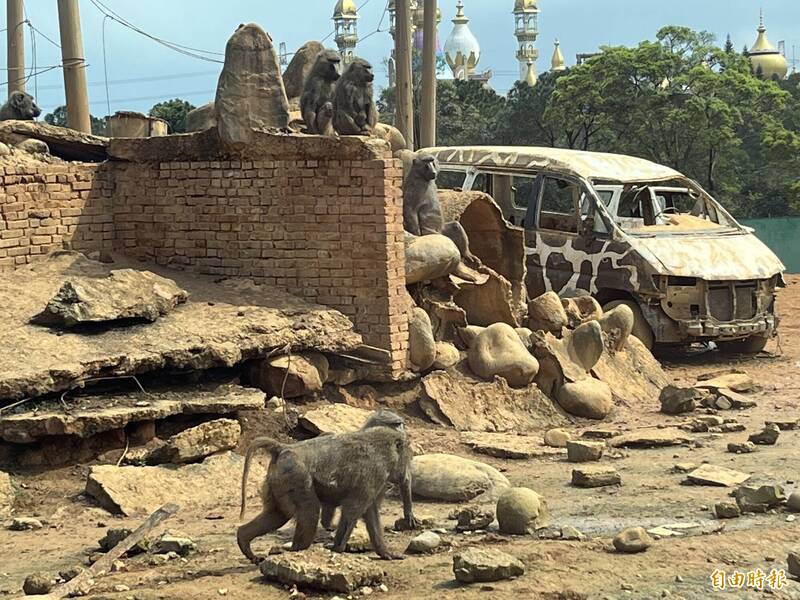This morning (31st), the Forestry Bureau of the Council of Agriculture, together with the Hsinchu County Government, experts and scholars, took a bus to investigate the baboon breeding site of the Liufu Village Wildlife Park.
(Photo by reporter Liao Xueru)
[Reporter Liao Xueru/Hsinchu Report] The Forestry Bureau of the Council of Agriculture, together with the Hsinchu County Government, experts and scholars, took a bus to survey the baboon breeding site in Liufu Village Wildlife Park this morning (31st). The Forestry Bureau and experts interviewed after preliminary investigation , it is recommended to strengthen the wall and internal facilities, including designing a variety of recreational spaces; experts also provide the feasibility of using the AI identification model to assist the park to calculate the number of baboons.
The aftermath of the escape incident of baboons at the Leofoo Village Zoo was lingering. It was reported that an employee of Leofoo Village said that the number of baboons in the park had already exceeded 250. Leofoo Village responded last night, "Everything needs to be done and confirmed after the inventory results are released."
Please read on...
Zheng Yijuan, Director of the Wildlife Conservation Section of the Forestry Bureau, said that AI scholars are specially invited today to survey and evaluate the group breeding of baboons in a wide area. Suggestions for environmental improvement are also put forward on how to strengthen the monitoring of the park through technology, whether the fence part needs to be strengthened, and internal facility problems.
Zheng Yijuan said that today we will first discuss whether the park environment and animal behavior are in line with animal welfare, and the implantation of chips will be discussed later.
In the future, in addition to requiring Leofoo Village to strengthen animal management, it will also gradually establish databases for protected wild animals in public and private zoos.
Chen Zhengwen, director of the Agricultural Science and Technology Research Institute, said that there are three main ways to count the number of animals. The first is to estimate the number of animals based on the sampling method, and the second is to use manual counting, such as marking animals or implanting microchips. The benefits of microchips It is easy to track, but difficult to implement; the third is to use AI technology.
With the support of the government program, the hospital cooperates with the National High Speed Network Computing Center, but the premise is that all animals can be photographed, and the acquisition of images is very important.
Chen Zhengwen pointed out that if the park has a way to set up a camera machine in the baboon park to obtain images every day, the machine will help manpower to calculate.
The accuracy depends on three conditions. After obtaining the image, a group of experts must be appointed to interpret the position. After machine learning, it can be identified through AI.
However, due to the large size of the baboon area, the vigorous activity of the baboon, and the resolution of the camera, etc., will affect the accuracy of AI recognition.
If the park can develop a strategy for installing cameras, it can cooperate with the institute and the National High Speed Network Computing Center; but the whole process will take several months.
Wang Ying, a professor of the Department of Life Sciences at National Normal University, said that baboons are social animals, and they will produce small families and each have their own territory. Clans hide or rest.
Because if a group grows to a certain size, it is more likely to cause social disturbances, and some individuals may be forced to flee at this time.
This morning (31st), the Forestry Bureau of the Council of Agriculture, together with the Hsinchu County Government, experts and scholars, took a bus to investigate the baboon breeding site of the Liufu Village Wildlife Park.
(Photo by reporter Liao Xueru)
The Forest Service and experts were interviewed after the initial survey and suggested strengthening the wall and internal facilities, including designing a variety of recreational spaces. The experts also provided the feasibility of calculating the number of baboons in Xigong Park through the AI identification model.
(Photo by reporter Liao Xueru)
The Forest Service and experts were interviewed after the initial survey and suggested strengthening the wall and internal facilities, including designing a variety of recreational spaces. The experts also provided the feasibility of calculating the number of baboons in Xigong Park through the AI identification model.
(Photo by reporter Liao Xueru)
The Forest Service and experts were interviewed after the initial survey and suggested strengthening the wall and internal facilities, including designing a variety of recreational spaces. The experts also provided the feasibility of calculating the number of baboons in Xigong Park through the AI identification model.
(Photo by reporter Liao Xueru)
